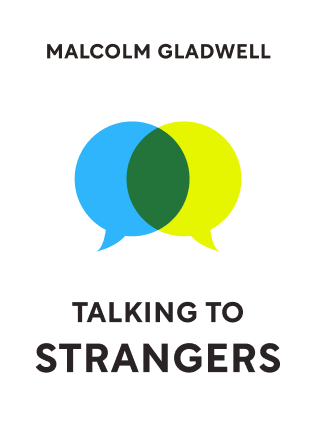

This article is an excerpt from the Shortform book guide to "Talking to Strangers" by Malcolm Gladwell. Shortform has the world's best summaries and analyses of books you should be reading.
Like this article? Sign up for a free trial here .
What is the illusion of transparency? How does it affect our interactions with people, in particular, strangers?
The illusion of transparency is an assumption that people project their true self through their outward behavior and demeanor. However, people are far from transparent, which can make us misinterpret others’ intentions and fall prey to deceit, especially with strangers.
Keep reading for more about the illusion of transparency.
What Is Transparency?
Meeting a stranger can make it more challenging to make sense of that person than not meeting him. That’s because people are prone to the so-called illusion of transparency.
Transparency refers to the assumption that the way people present themselves outwardly (through behavior and demeanor) is an accurate and reliable representation of their inner feelings and intentions. But that’s an unrealistic assumption to make when dealing with strangers.
Before we explore why we can’t assume others will be transparent, let’s look at how transparency works.
The Illusion of Transparency and How It Works
Facial expressions are one of the primary ways that we interpret a stranger’s feelings (because we mistakenly assume that a person’s demeanor is an accurate representation of his feelings).
Coded Facial Actions
Psychologist Jennifer Fugate is an expert in the system of coding facial actions (referred to here as FACS). FACS assigns a name, or “action unit,” to each of the 43 possible muscle movements of the face. This action unit is used to notate and score people’s facial expressions like music is scored by notes on a page. For example:
- The kind of soft, insincere-seeming smile you would get from a flight attendant has a score of AU 12, based on the facial motions used to create that expression: Pulling up the corners of the lips, and leaving the rest of the face still.
- A genuine-seeming smile has a score of AU 12 plus AU 6. The corners of the lips pull up and the cheeks raise to crinkle the eyes.
It is important to note that these smiles only seem to be insincere or genuine based on how they look. People’s expressions are not always transparent, as discussed below.
Transparency and Friends
Friends is one of the most successful and recognizable shows of all time—in part because the characters are completely transparent. To prove the connection between transparency and the success of Friends, Jennifer Fugate watched the first scene of season five, episode 15 and performed a FACS analysis of each character’s expressions throughout.
At the beginning of the episode, Ross sees Chandler and Monica in a romantic moment. This is significant because Chandler is Ross’s best friend and Monica is Ross’s sister. Ross rushes to Monica’s apartment to bust in and stop them. He is frantic. Joey and Rachel come into the scene, while Chandler hides behind Monica to stay out of Ross’s warpath. Monica and Chandler announce that they are in love. Slowly, Ross comes around to being happy for them.
That might seem like a lot to keep up with, but Friends is incredibly easy to follow. Why is that? Because the characters are transparent, as Jennifer Fugate proved with her FACS reading of the scene.
The Results
- In the moment that Ross sees Chandler and Monica embrace, his face reads: upper-lip raise, lower-lip depress, lips part, and jaw drop—all at the highest intensity rating. This is the stereotypical look of anger and disgust.
- In the moment that Monica tells Ross she’s sorry for surprising him but that she’s in love with Chandler, her face reads: 1 + 2, which communicates classic sadness, then eyebrow raise, then the AU 12 flight attendant smile. This combines to express that she is sad to upset Ross, but happy to be with Chandler.
- In that same moment, Ross’s face reads: 1 + 2, classic sadness, then 1 + 12, the beginnings of happiness. His sadness has shifted into joy when he sees that Monica is happy.
Fugate’s FACS reading proves that the actors in Friends portray every emotion their character goes through inwardly directly through their facial expressions—the characters are completely transparent. The show’s popularity is evidence that people like dealing with transparent people (and characters). Transparency makes people and their stories easier to understand.
When we meet strangers, we tend to believe that they’ll be as transparent as the characters on Friends. This is the “Friends Fallacy.” It’s a fallacy because real life isn’t like an episode of Friends. In reality, strangers often aren’t transparent. So why do we assume they are?
Is the Illusion of Transparency Beneficial?
In The Expression of the Emotions in Man and Animals by Charles Darwin, Darwin argues that it is beneficial to human survival that people are able to quickly and accurately communicate emotions to one another.
The ability to smile, frown, and wrinkle the nose in disgust are some examples of how the human face evolved as a tool to represent internal feelings. This will probably strike you as a relatively obvious principle. After all, children everywhere naturally smile when they’re happy and frown when they’re sad, and that helps them get what they need to survive. So it seems reasonable to assume transparency.
But you should be careful not to assume that every stranger you come across will be transparent. That assumption requires everyone you meet to express themselves in the same predictable ways. Unfortunately, that is not the case.
People are Not Transparent
Transparency is an illusion. Because we have all watched the same TV shows, like Friends, and read the same novels where a character’s “jaw drops in surprise,” we have been conditioned to believe that there is only one expression associated with any particular emotion. But that is unrealistic.
In reality, it takes getting to know someone well to be able to read their outward demeanor accurately. With a close friend, you come to understand their idiosyncratic expressions and what they mean to express. But when you encounter a stranger, you often have to make assumptions based on their expressions because you don’t have any personal experience with that person. But your assumptions are based on stereotypes, like Ross’s exaggerated facial expressions in Friends, that are usually wrong.
Example:
One day, George goes to take a shower. Suddenly, from the bathroom, he hears his wife scream. George runs to the kitchen and sees a man holding a knife to his wife’s throat. George is naked and wet from the shower, but he intimidatingly yells at the assailant, “Get out of here NOW.” The young man gets scared and flees the scene.
On the inside, George was absolutely terrified for his wife’s safety in that moment. But he didn’t show it on the outside. Maybe someone who knew him well would have been able to tell that George’s intimidating demeanor was his natural reaction to fear, but the assailant (a stranger) had no way to know that.
What did the assailant assume about George based on his intimidating expression—that he was dangerous, violent, cold, or something else completely? The intruder mistakenly assumed transparency (which was lucky for George and his wife).
The Illusion of Transparency Can Be Dangerous
The bail hearings described in the section Judges vs. Artificial Intelligence are another exercise in transparency. Judges who look at their defendants make more mistakes in judging character than a computer that never sees the defendants at all. Watching someone’s facial expressions is not a fail-proof way to see how that person is feeling. Someone who is surprised might not show it, and someone who is dangerous might come across as stereotypically demure.
Patrick Dale Walker
A man named Patrick Dale Walker was arrested in Texas for trying to kill his girlfriend. The only reason he didn’t succeed in murdering her was that the gun jammed when he pulled the trigger. The judge presiding over the case set bail at $1 million, and Walker went to prison. But four days later, the judge lowered the bail to $25,000 and Walker was released.
The judge reasoned that four days in jail would be enough for Walker to “cool off.” He saw Walker as a polite young man with a clean record. Most important, he saw that Walker was remorseful for what he had done. But could he really see something like remorse in a stranger? Apparently not. Walker shot his girlfriend to death four months later.
In this case, seeing Walker made the judge worse at interpreting his intentions. The information the judge thought he gleaned from observing Walker’s seemingly remorseful behavior was actually misinformation, because Walker was not transparent.

———End of Preview———
Like what you just read? Read the rest of the world's best book summary and analysis of Malcolm Gladwell's "Talking to Strangers" at Shortform .
Here's what you'll find in our full Talking to Strangers summary :
- Why we don't understand strangers
- How to talk to strangers in a cautious way so you don't get fooled
- How Hitler deceived so many world leaders






